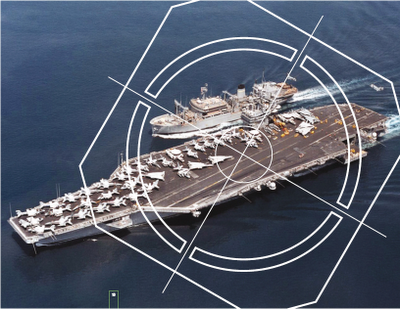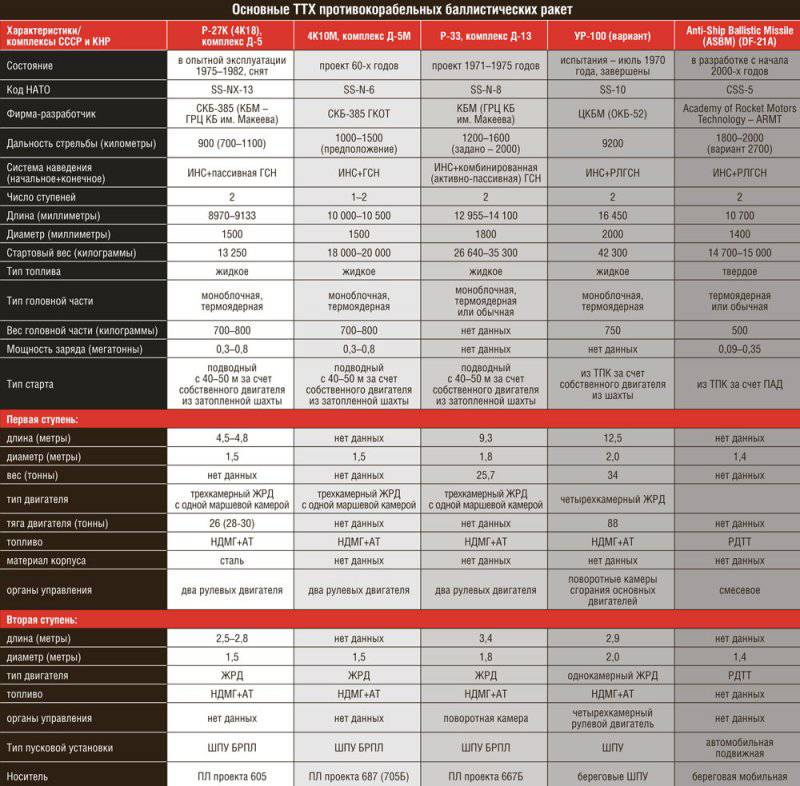Ballistic missiles - on aircraft carriers
 Did the Celestial Empire succeed in what the USSR could not do?
Did the Celestial Empire succeed in what the USSR could not do?According to military analysts, in the very near future, China may begin deploying land-based DF-21 ballistic missiles in an anti-ship variant capable of hitting moving naval targets. It is assumed that the use of such BR will allow the destruction of aircraft carriers, despite the presence of a variety of means of air defense and missile defense on the carrier-assault groups.
This will help the Celestial Empire to greatly strengthen the influence of its fleet at the naval theater of operations adjacent to the coast of China, to pose a serious threat (at least to this theater) by the US Navy, whose power relies primarily on “floating airfields”.
Problems remained
Incidentally, story rocket application weapons to fight the ships of the enemy originates not in the past century, but much earlier. And here our compatriots proved themselves to be innovators. It is known that in 1834 – 1838, the Russian military and inventor A. A. Schilder worked on the possibility of using combat missiles in the navy and suggested launching them from submarines. The construction of a riveted metal construction developed by Schilder was started in March and completed in May 1834 in St. Petersburg at the Aleksandrovsky Foundry. It was just intended for striking powder rockets at enemy ships at anchor, as well as at enemy squadrons passing through the straits.
The first studies and experiments with guided ballistic missiles that could be used to solve anti-ship missions were carried out in the Soviet Union in the 60 – 70s, in general, for the same reason that the Chinese are doing it today. But then our rocket R-27K was only in trial operation and was not accepted for service.
However, time has changed, but problems remained. At the same time, according to foreign experts, modern technologies make it possible to create a ballistic missile warhead with a radar guidance system or an infrared system to ensure the defeat of large moving targets such as an aircraft carrier or other large displacement warship.
Today ahead of the rest
The press, relying on information from American intelligence and Pentagon analyst assumptions, reported that China may have been developing a new class anti-ship weapon. According to the United States Naval Institute (The United States Naval Institute, a non-governmental organization. - Approx. Ed.), Information about these weapons was published in one of the Chinese specialized publications, which the US military experts consider to be a fairly reliable source. Then the translation and a more detailed description of the rocket system appeared on the naval portal Information Dissemination.
We are talking about ballistic missiles designed to destroy surface ships, primarily aircraft carriers. New weapons received the symbol Anti-Ship Ballistic Missile (ASBM). It is assumed that its development is based on the DF-21 medium-range missile (Dong Feng 21, another designation CSS-5) with a firing range of about 1500 kilometers.
The ballistic missile system (BRK) with the DF-21 “Dongfeng-21” strategic missile began to enter service with the People’s Liberation Army of China from 1991 onwards. Now the mobile compact two-stage "Dongfeng-21" replaces the "Dongfeng-3" at the missile bases "Jianshui", "Tonhua", "Lienshiwan", where they are deployed around 50 of such BRs. From here they are able to hit targets located in Northern India, on the territory of the states of Central Asia, as well as Vietnam and other countries of Southeast Asia. On the basis of the DF-21 rocket, a new medium-range DF-21X rocket is created, capable of flying 3000 kilometers, which is supposed to use GPS technology to improve the accuracy of hitting the control system. The development will take about ten years, the power of the warhead on the rocket should be 90 kilotons.
ASBM is equipped with a sophisticated guidance system with a radar homing head and target selection on the terminal part of the trajectory, which probably resembles the control system installed on the American Pershing II BR. However, as you know, at the end of the 80s, these missiles were decommissioned by the US Army and destroyed under an agreement to eliminate medium and shorter-range missiles. At the same time, the Pershing II homing system was designed to engage ground well-defended targets with an accuracy of up to 30 meters and guidance was carried out in comparison with a reference radar image of the terrain. Such accuracy forced to think about the security of their command posts.
In the proposed radar homing system of the Chinese ASBM missile, mobile naval targets such as a large warship and aircraft carrier were selected as the main targets of destruction. A similar task is no less difficult than the one that was assigned to the Pershing II BR. Therefore, the DF-21-based missile homing system is more likely to resemble a homing head (radar sighting) of cruise anti-ship missiles, especially since, as already mentioned, some of them have high supersonic speeds comparable to the speed of a medium-range ballistic missile combat unit . AGM-69 SRAM (USA) and X-15 (Russia) aeroballistic missiles are examples of medium-range air-to-surface missiles. The anti-ship variant X-15С was equipped with a radar homing head (RLGSN) on the final leg of the flight.
But back to the ASBM Chinese anti-ship ballistic missile. According to experts, the emergence of such weapons can significantly increase the security of mainland China from the sea. By countering the threat of the appearance of enemy surface units near its borders, ASBM is able to radically change the nature of hostilities in the coastal seas, as well as the development prospects and existing aircraft carrier construction programs.
No alternative?
The latter statement is controversial, since the long research and development of reliable means of combating US carrier strike assaults in the Soviet Union did not lead to significant results. And a successful alternative to the concept that the main adversary of the aircraft carrier - the aircraft carrier, apparently, has not been found so far. Moreover, great attention was paid to solving this problem in the Navy of the USSR, it was the second most important after the strategic task - delivering a nuclear strike on the coastal targets of a potential enemy and destroying his SSBNs. According to a number of experts, for our forces operating in the oceans and over its expanses, the struggle with American aircraft carriers stood in the first place. For this, in addition to submarines with cruise missiles, missile cruisers and marine missile-carrying aviation long-range aviation was involved.
According to news agencies, ASBM can fly about 1800 – 2000 kilometers. Rocket travels this distance in 12 minutes. In the middle of 2011, the Chinese newspaper China Daily published a small piece of material based on the comments of the PLA General Staff Chief Chen Bingde. The note reported that the firing range of anti-ship BR DF-21D, based on "revolutionary technologies", is 2700 kilometers.
This will allow the Chinese military to control the areas of possible confrontation between Beijing and Washington, related to disagreements over the future fate of the island nation in Taiwan.
According to analysts, thanks to the energy capabilities and dimensions of a two-stage fifteen-ton rocket, it can carry a combat charge (in non-nuclear equipment about 500 kilograms) of sufficient power to cause serious damage to large surface ships, including aircraft carriers. Some experts suggest that ASBM is capable of sinking even the largest American aircraft carrier from the first hit. By the way, the standard version of the DF-21 rocket is equipped with an 300-kiloton nuclear warhead.
There is an assumption that the Chinese anti-ship BR will be aimed at the target using satellites, radar systems, or receive information about the target from unmanned aerial vehicles. However, it is known that the Celestial Empire does not have its own full-featured satellite navigation system. CRNS “Northern Bucket” (“The Big Dipper”) BeiDou-2 on 2 December 2011 had six of the necessary 30 NCAs, and BeiDou-1 consisted of three NCAs. Hope for the American GPS in the event of a conflict with the United States (and no other country has a carrier fleet, the destruction of which requires such powerful weapons), of course, nothing. At the same time, China can take advantage of the Russian GLONASS space navigation system, which has recently been significantly increased and pushed through the international market, or its Beidou.
It is now known that China is developing a new over-the-horizon radar station that will be able to detect large ships like aircraft carriers at a distance of up to three thousand kilometers and use this data to send missiles. Similar radars were used in the USA and the USSR for detecting heavy bombers and launching intercontinental ballistic missiles. Currently, over-the-horizon radar stations of various modifications are in service with Russia, the USA, China and Australia. Later modifications of such stations were focused on solving the problem of controlling the surface situation.
Here we can recall the coastal trans-horizon surface-mounted radar (BZGR) “Sunflower-E” of the short-wave range of radio waves, which is intended for use in coastal monitoring systems of the surface and air situation within the 200-mile economic zone of the coastal state. It was created in the Russian JSC NPK NIIDAR.
New Chinese-made radar stations are believed to be used to combat the US Navy aircraft carriers in conjunction with the DF-21 anti-ship missiles.
Probably, the ASBM anti-ship ballistic missile has low visibility (Stealth technology) for the radar and has a high level of maneuverability, making the flight path unpredictable for the enemy. As believed in the US military department, tests of "aircraft carrier killers" could have been carried out back in 2005 – 2006.
It remains not entirely clear how far the anti-shipping version of the Chinese DF-21 rocket, if it actually exists, and is not just another “duck”, has progressed in the possibilities of hitting moving naval targets. It is also not known whether Chinese scientists and designers managed to create a compact homing head (GOS) with unique characteristics for a ballistic missile combat unit, as well as a control system for combat unit maneuvers by the commands of this GSN.
Already at the beginning of the 80-ies to destroy the carrier-based and large amphibious units of a potential enemy on the approaches to the shores of the European part of the USSR and the Warsaw Pact countries based on the 15ХХ45 medium-range missile of the Pioneer mobile complex and target designation systems of the Navy MKRTS Legenda and MRTS " Success ”The Moscow Institute of Thermal Engineering (MIT) was working on the coastal reconnaissance-strike system (RUS). Work on this system was stopped in the middle of the 80-ies due to the high costs of creation and in connection with the negotiations on the elimination of medium-range missiles. And in the class of Chinese anti-ship counterpart corresponds to this development.
And what will happen next with anti-ship BR, time will tell ...

Information